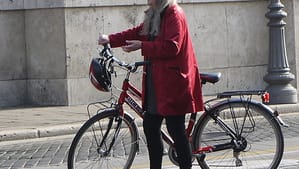Stay in the Loop
BSR publishes on a weekly schedule, with an email newsletter every Wednesday and Thursday morning. There’s no paywall, and subscribing is always free.
Rome redux
'SPQR: A History of Ancient Rome' by Mary Beard

Mary Beard, the English classics scholar, came to the cozy Montgomery Auditorium at the Central Library to talk about her new 600-page book, which has the snappy title SPQR: A History of Ancient Rome.
By presenting a sampling of her insights into the history of Roman civilization in a spirited, learned, and accessible manner, her lecture was not just a good advertisement for and introduction to her long and massive study, it was good performance art.
Her appearance and personality helped. She has a genial, larger-than-life way about her, together with a distinct and vivid British manner of speaking. Owlish with a large oval face framed by a great deal of long gray hair, and wearing a yellow smock, this Cambridge don, for all her academic authority, came across as also a bit of a nanny, friendly and approachable, good-humored and lacking all pretension or pomposity.
Thankfully, her sparkling brilliance and articulateness were admirable and inviting rather than off-putting, as she offered a lively potpourri of topics accompanied by a slide show.
“New history” is not an oxymoron
Why a new history, she asked, aren’t there quite a lot of them already? Well, for one thing, there are new discoveries being made all the time, often through archaeology and the application of modern science. There are things to learn about pollution, diet, and the geographical mobility of people, for instance, from analysis of ice, cesspit compost, and teeth. Just in the last 50 years, a vast amount of new knowledge of all varieties has been found.
And interests of the present are always in conversation with the past. The advent of the modern feminist movement, she said, has broadened the treatment of women in Roman society. Traditional history was based mainly on the lives, thoughts, outlook, deeds, and misdeeds of rich Roman men, while her own approach offers vivid narratives of daily life of the wider population, including slaves.
Just lucky, I guess
Beard is more interested in the rise of Rome than its decline and fall. How did a plain, insignificant village in Italy eventually come to rule the whole of the western world? She seems to feel that it will always be something of mystery and offered no definitive explanations, saying disarmingly that maybe it just got lucky.
She was especially excited about the discovery, just a few days before her talk, of a gold signet ring belonging to the early Roman consul Scipio Barbatus,  whose sarcophagus is well known and copied in modern times. The ring was found in a British castle, and we got to see a slide of it, the only ancient ring identified as the belonging of a specific person.
whose sarcophagus is well known and copied in modern times. The ring was found in a British castle, and we got to see a slide of it, the only ancient ring identified as the belonging of a specific person.
She was lively and deft in the Q&A, ably fielding several diverse questions. The appreciative full house included a contingent from Friends Select School wearing (imperial) purple T-shirts with Latin slogans. All in all, the lecture itself was a highly civilized pleasure, like eating tea and cakes. The experience reminded me of the Latin classes in which I studied the Senate and People of Rome, a mere 40 years ago. Tempus fugit (Time flies).
What, When, Where
SPQR: A History of Ancient Rome by Mary Beard. Liveright, 2015. Available at Amazon.
Author event on November 10, 2015 at the Free Library of Philadelphia, 1900 Vine Street, Philadelphia. freelibrary.org/authorevents
Sign up for our newsletter
All of the week's new articles, all in one place. Sign up for the free weekly BSR newsletters, and don't miss a conversation.
